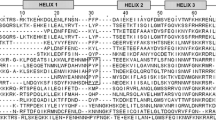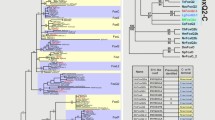Abstract
Homeobox-containing genes play crucial roles in various developmental processes, including body-plan specification, pattern formation and cell-type specification. The present study searched the draft genome sequence and cDNA/EST database of the basal chordate Ciona intestinalis to identify 83 homeobox-containing genes in this animal. This number of homeobox genes in the Ciona genome is smaller than that in the Caenorhabditis elegans, Drosophila melanogaster, human and mouse genomes. Of the 83 genes, 76 have possible human orthologues and 7 may be unique to Ciona. The ascidian homeobox genes were classified into 11 classes, including Hox class, NK class, Paired class, POU class, LIM class, TALE class, SIX class, Prox class, Cut class, ZFH class and HNF1 class, according to the classification scheme devised for known homeobox genes. As to the Hox cluster, the Ciona genome contains single copies of each of the paralogous groups, suggesting that there is a single Hox cluster, if any, but genes orthologous to Hox7, 8, 9 and 11 were not found in the genome. In addition, loss of genes had occurred independently in the Ciona lineage and was noticed in Gbx of the EHGbox subclass, Sax, NK3, Vax and vent of the NK class, Cart, Og9, Anf and Mix of the Paired class, POU-I, III, V and VI of the POU class, Lhx6/7 of the LIM class, TGIF of the TALE class, Cux and SATB of the Cut class, and ZFH1 of the ZFH class, which might have reduced the number of Ciona homeobox genes. Interestingly, one of the newly identified Ciona intestinalis genes and its vertebrate counterparts constitute a novel subclass of HNF1 class homeobox genes. Furthermore, evidence for the gene structures and expression of 54 of the 83 homeobox genes was provided by analysis of ESTs, suggesting that cDNAs for these 54 genes are available. The present data thus reveal the repertoire of homeodomain-containing transcription factors in the Ciona genome, which will be useful for future research on the development and evolution of chordates.


Similar content being viewed by others
References
Aniello F, Locascio A, Villani MG, Di Gregorio A, Fucci L, Branno M (1999) Identification and developmental expression of Ci-msxb: a novel homologue of Drosophila msh gene in Ciona intestinalis. Mech Dev 88:123–126
Banerjee-Basu S, Baxevanis AD (2001) Molecular evolution of the homeodomain family of transcription factors. Nucleic Acids Res 29:3258–3269
Bodmer R (1993) The gene tinman is required for specification of the heart and visceral muscles in Drosophila. Development 118:719-729
Boucher CA, Winchester CL, Hamilton GM, Winter AD, Johnson KJ, Bailey ME (2000) Structure, mapping and expression of the human gene encoding the homeodomain protein, SIX2. Gene 247:145–151
Brooke NM, Garcia-Fernàndez J, Holland PWH (1998) The ParaHox gene cluster is an evolutionary sister of the Hox gene cluster. Nature 392:920–922
Burglin TR (1994) A comprehensive classification of homeobox genes. In: Duboule D (ed) Guidebook to the homeobox genes. Oxford University Press, New York, pp 27–64
Burglin TR (1995) The evolution of homeobox genes. In: Arai R, Kato M, Doi Y (eds) Biodiversity and Evolution. The National Science Museum Foundation, Tokyo, pp 291–336
Burglin TR (1997) Analysis of TALE superclass homeobox genes (MEIS, PBC, KNOX, Iroquois, TGIF) reveals a novel domain conserved between plants and animals. Nucleic Acids Res 25:4173–4180
Burglin TR, Cassata G (2002) Loss and gain of domains during evolution of cut superclass homeobox genes. Int J Dev Biol 46:115–123
Burglin TR, Ruvkun G (2001) Regulation of ectodermal and excretory function by the C. elegans POU homeobox gene ceh-6. Development 128:779–790
Caracciolo A, Di Gregorio A, Aniello F, Di Lauro R, Branno M (2000) Identification and developmental expression of three Distal-less homeobox containing genes in the ascidian Ciona intestinalis. Mech Dev 99:173–176
Chi N, Epstein JA (2002) Getting your Pax straight: Pax proteins in development and disease. Trends Genet 18:41–47
Chi YI, Frantz JD, Oh BC, Hansen L, Dhe-Paganon S, Shoelson SE (2002) Diabetes mutations delineate an atypical POU domain in HNF1α. Mol Cell 10:1129–1137
Christiaen L, Burighel P, Smith WC, Vernier P, Bourrat F, Joly JS (2002) Pitx genes in Tunicates provide new molecular insight into the evolutionary origin of pituitary. Gene 287:107–113
Corrado M, Aniello F, Fucci L, Branno M (2001) Ci-IPF1, the pancreatic homeodomain transcription factor, is expressed in neural cells of Ciona intestinalis larva. Mech Dev 102:271–274
Coulier F, Popovici C, Villet R, Birnbaum D (2000) MetaHox gene clusters. J Exp Zool 288:345–351
Dehal P, Satou Y, Campbell RK, et al (2002) The draft genome of Ciona intestinalis: insights into chordate and vertebrate origins. Science 298:2157–2167
Di Gregorio A, Spagnuolo A, Ristoratore F, Pischetola M, Aniello F, Branno M, Cariello L, Di Lauro R (1995) Cloning of ascidian homeobox genes provides evidence for a primordial chordate cluster. Gene 156:253–257
Dozier C, Kagoshima H, Niklaus G, Cassata G, Burglin TR (2001) The Caenorhabditis elegans Six/sine oculis class homeobox gene ceh-32 is required for head morphogenesis. Dev Biol 236:289–303
FANTOM Consortium and RIKEN Genome Exploration Research Group Phase I & II Team (2002) Analysis of the mouse transcriptome based on functional annotation of 60,770 full-length cDNAs. Nature 420:563–573
Ferrier DEK, Holland PWH (2002) Ciona intestinalis ParaHox genes: evolution of Hox/ParaHox cluster integrity, developmental mode, and temporal colinearity. Mol Phylogenet Evol 24:412
Ferrier DEK, Minguillon C, Holland PWH, Garcia-Fernàndez J (2000) The amphioxus Hox cluster: deuterostome posterior flexibility and Hox14. Evol Dev 2:284–293
Ferrier DEK, Minguillon C, Cebrian C, Garcia-Fernàndez J (2001) Amphioxus Evx genes: implications for the evolution of the midbrain-hindbrain boundary and the chordate tailbud. Dev Biol 237:270-281
Galliot B, de Vargas C, Miller D (1999) Evolution of homeobox genes: Q50 Paired-like genes founded the Paired class. Dev Genes Evol 209:186–197
Garcia-Fernàndez J, Holland PWH (1994) Archetypal organization of the amphioxus Hox gene cluster. Nature 370:563–566
Gionti M, Ristoratore F, Di Gregorio A, Aniello F, Branno M, Di Lauro R (1998) Cihox5, a new Ciona intestinalis Hox-related gene, is involved in regionalization of the spinal cord. Dev Genes Evol 207:515–523
Giuliano P, Marino R, Pinto MR, De Santis R (1998) Identification and developmental expression of Ci-isl, a homologue of vertebrate islet genes, in the ascidian Ciona intestinalis. Mech Dev 78:199–202
Gomez-Skarmeta JL, Modolell J (2002) Iroquois genes: genomic organization and function in vertebrate neural development. Curr Opin Genet Dev 12:403–408
Hallonet M, Hollemann T, Wehr R, Jenkins NA, Copeland NG, Pieler T, Gruss P (1998) Vax1 is a novel homeobox-containing gene expressed in the developing anterior ventral forebrain. Development 125:2599–2610
Harris TW, Lee R, Schwarz E, Bradnam K, Lawson D, Chen W, Blasier D, Kenny E, Cunningham F, Kishore R, Chan J, et al (2003) WormBase: a cross-species database for comparative genomics. Nucleic Acids Res 31:133–137
Hobert O, Westphal H (2000) Functions of LIM-homeobox genes. Trends Genet 16:75–83
Holland PWH (1991) Cloning and evolutionary analysis of msh-like homeobox genes from mouse, zebrafish and ascidian. Gene 98:253–257
Hudson C, Lemaire P (2001) Induction of anterior neural fates in the ascidian Ciona intestinalis. Mech Dev 100:189–203
Imai KS, Satoh N, Satou Y (2002) Region specific gene expressions in the central nervous system of the ascidian embryo. Gene Exp Patt 2:319–321
International Human Genome Sequencing Consortium (2001) Initial sequencing and analysis of the human genome. Nature 409:860–921
Lannoy VJ, Burglin TR, Rousseau GG, Lemaigre FP (1998) Isoforms of hepatocyte nuclear factor-6 differ in DNA-binding properties, contain a bifunctional homeodomain, and define the new ONECUT class of homeodomain proteins. J Biol Chem 273:13552–13562
Locascio A, Aniello F, Amoroso A, Manzanares M, Krumlauf R, Branno M (1999) Patterning the ascidian nervous system: structure, expression and transgenic analysis of the CiHox3 gene. Development 126:4737–4748
Martinez P, Rast JP, Arenas-Mena C, Davidson EH (1999) Organization of an echinoderm Hox gene cluster. Proc Natl Acad Sci USA 96:1469–1474
Ogasawara M, Wada H, Peters H, Satoh N (1999) Developmental expression of Pax1/9 genes in urochordate and hemichordate gills: insight into function and evolution of the pharyngeal epithelium. Development 126:2539–2550
Pollard SL, Holland PWH (2000) Evidence for 14 homeobox gene clusters in human genome ancestry. Curr Biol 10:1059–1062
Popodi E, Kissinger JC, Andrews ME, Raff RA (1996) Sea urchin Hox genes: insights into the ancestral Hox cluster. Mol Biol Evol 13:1078–1086
Rubin GM, Yandell MD, Wortman JR, Gabor Miklos GL, Nelson CR, Hariharan IK, Fortini ME, Li PW, Apweiler R, Fleischmann W, et al (2000) Comparative genomics of the eukaryotes. Science 287:2204–2215
Satou Y, Yamada L, Mochizuki Y, Takatori N, Kawashima T, Sasaki A, Hamaguchi M, Awazu S, Yagi K, Sasakura Y, Nakayama A, Ishikawa H, Inaba K, Satoh N (2002) A cDNA resource from the basal chordate Ciona intestinalis. Genesis 33:153–154
Satou Y, Imai KS, Levine M, Kohara Y, Rokhsar D, Satoh N (2003) A genomewide survey of developmentally relevant genes in Ciona intestinalis. I. Genes for bHLH transcription factors. Dev Genes Evol DOI 10.1007/s00427-003-0319-7
Scott MP (1992) Vertebrate homeobox gene nomenclature. Cell 71:551–553
Seo HC, Curtiss J, Mlodzik M, Fjose A (1999) Six class homeobox genes in Drosophila belong to three distinct families and are involved in head development. Mech Dev 83:127–139
Acknowledgements
This research was supported by Grants-in-Aid for Scientific Research from MEXT and JSPS, Japan, to Y.S. (14704070) and N.S. (12202001), and by a CREST project of Japan Science and Technology Corporation (N.S., E.S., and S.W.). K.K. was a Postdoctoral Fellow of JSPS with a research grant (14061430). We thank Kazuko Hirayama, Chikako Imaizumi, Asako Fujimoto, and Hisayoshi Ishikawa for their technical support.
Author information
Authors and Affiliations
Corresponding author
Additional information
Edited by D. Tautz
The first two authors contributed equally to this work
Electronic supplementary material
Rights and permissions
About this article
Cite this article
Wada, S., Tokuoka, M., Shoguchi, E. et al. A genomewide survey of developmentally relevant genes in Ciona intestinalis . Dev Genes Evol 213, 222–234 (2003). https://doi.org/10.1007/s00427-003-0321-0
Received:
Accepted:
Published:
Issue Date:
DOI: https://doi.org/10.1007/s00427-003-0321-0




